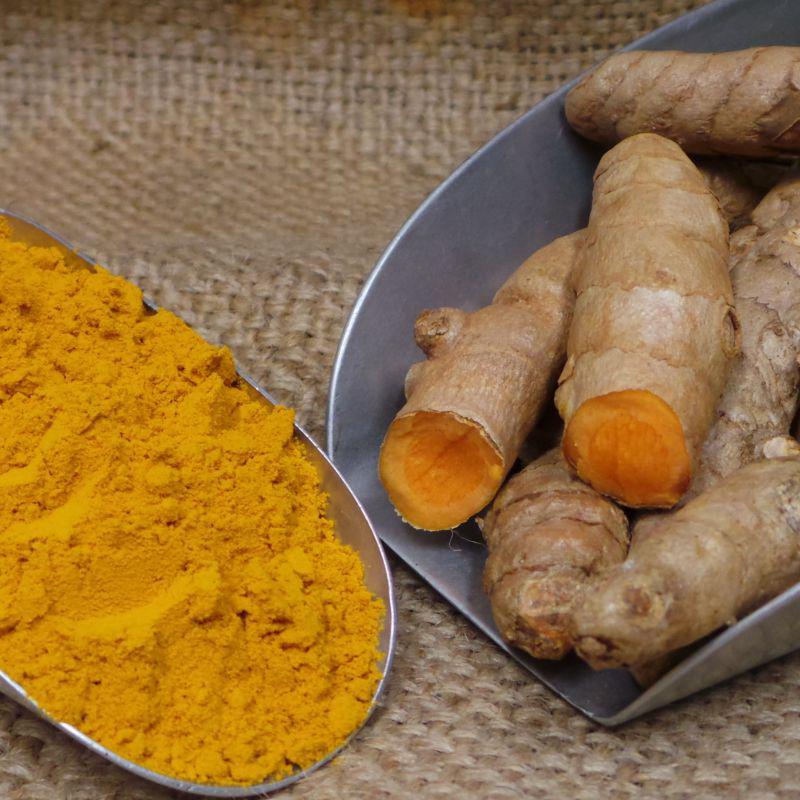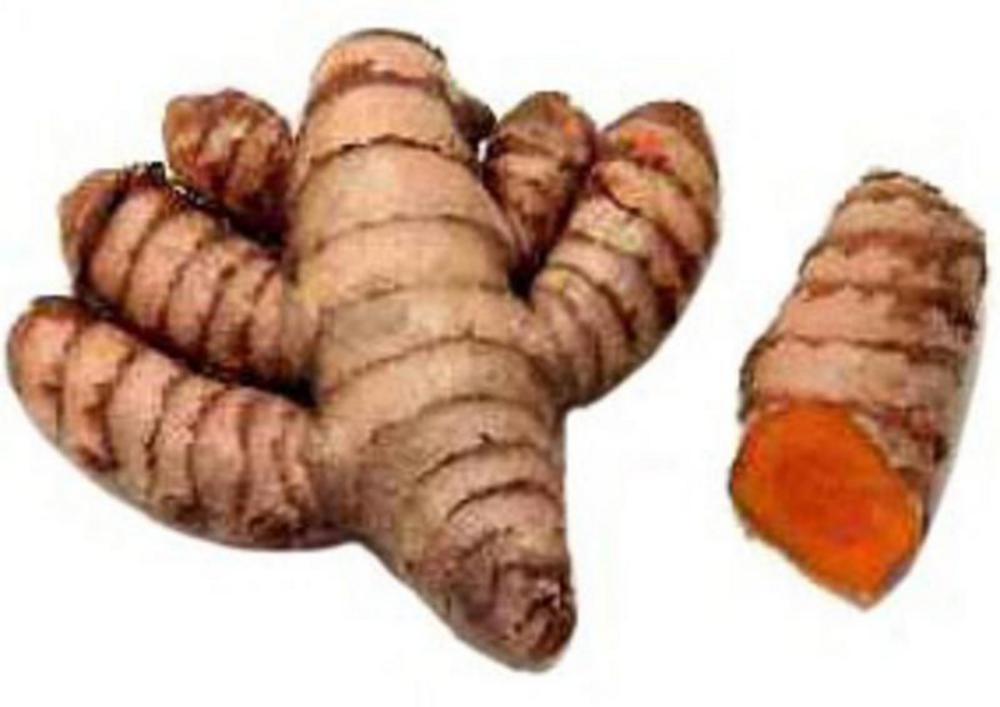We've been asked quite frequently about turmeric here at Real Foods. What's the curcumin content of the turmeric we sell... What is fresh turmeric used for ... Whether curcumin supplements have the same benefits as turmeric...? These are just a few of the regularly asked questions.
Here's all of our answers rounded up in a handy guide to the spice known in India as 'holy powder'. We've also a guide to making your own turmeric and castor oil pack to cleanse and rebalance the liver and gallbladder areas, popular with followers of Ayurvedic medicine.
 Turmeric Real Foods
Turmeric Real Foods
Turmeric
Turmeric (Curcuma longa) belongs to the ginger family and is native to southeast India. The root looks very similar to ginger but is smaller. When not used from fresh, the roots (or rhizomes) are boiled for around half an hour and then dried and ground, creating a deeply coloured orange/yellow powder that is widely used as a spice, healing remedy and dye. It has an earthy, warm, almost peppery flavour and smells somewhat similar to mustard (turmeric is widely used to give colour and scent to mustard condiments.) The leaves of the turmeric plant are also used to wrap and cook food, but this tends to be in areas the plant grows as they are used when freshly picked. Turmeric was called Indian saffron in mediaeval Europe as it was widely used as a cheaper alternative to saffron.
Turmeric and curcumin
Curcumin is a compound found in turmeric, approximately 2-3% (by weight) of turmeric is curcumin. It is being studied as the active constituent in turmeric. There are a wide variety of supplements available, including ones based simply on curcumin as well as the whole turmeric. However the oil found in turmeric is not solely curcumin; there are other curcuminoids (the family of natural phenols that cause the colouration in turmeric). The other phenols are desmethoxycurcumin and bis-desmethoxycurcumin. Curcumin is also known as food colouring E100 and diferuloylmethane. Many people advise using the whole of turmeric as a supplement or fresh/dried turmeric as a cheaper alternative to supplements.
 Real Foods Organic Fresh Turmerics
Real Foods Organic Fresh Turmerics
Turmeric and curcumin
Simply click on the name to take you to the product in our webshop.
One of our most popular items in our fresh fruit and vegetables section is fresh turmeric. A root vegetable, similar in appearance to ginger but smaller, fresh turmeric is widely used to add heat, flavour and colour to dishes. Used finely sliced and raw it perks up coleslaws and salads and adds a citrussy hit to any curry. Simply use it in a recipe that calls for dried turmeric to give your dishes a lift. Or pop in with rice to give a great colour and a zingy taste.
Wrap turmeric in a dry paper towel and place inside an unsealed plastic bag in the refrigerator. It will keep for 1 to 2 weeks. If you see any spots of mould, just cut them off, replace the paper towel, and use the remainder.
For longer storage, you can slice, wrap, and freeze turmeric for up to 2 months; however, it will lose its firm texture. If a recipe calls for mashed or minced turmeric, you can use it frozen.
Be warned – turmeric stains. It’s not used as a dye for no reason! Lemon juice should remove any discolouration of surfaces. 1 teaspoon of dried spice is roughly equal to 1 tablespoon of fresh if you are substituting.
Turmeric and curcumin
Turmeric is grown from the roots not from seed. You can use fresh roots, but it’s worth buying several as not all of them will sprout. Buy fresh turmeric here. Your plants won’t be able to tolerate any climate colder than around 17 degrees Celsius outside, which is pretty rare for the UK. They can also be grown indoors. It takes 8- 10 months for a new crop of roots to develop, and this is not a plant that you can harvest in small pieces through the season.
A root (or rhizome) has several branches or fingers. You can break these apart and start more than one plant if you prefer. Bury the root under 2 inches of loose potting soil and if there are any knobs or buds on the root, turn them so they are facing upwards. This will help it to sprout.
Keep it damp but not soaking wet or the root may rot. In a month or two, you should see sprouts come up. It will quite possibly grow too large for a windowsill as it thrives in the sun. Choose a container that is at least 12 inches across and the same in depth to give your plants room to grow.
Water potted turmeric regularly to keep the soil damp, and weekly feedings with mild or diluted fertiliser are very beneficial.
You will have to take care of your plant for 8 to 10 months before harvest time. Eventually, the plant will start to turn yellow and the leaves will start to dry out. That’s when your turmeric is ready to dig up. Just dig up the plant and cut the rhizomes away from the stems. Wash off the dirt and it’s ready to use. For more turmeric, take one or two pieces of root and start another plant. If you are careful, it is possible to harvest a few root pieces without having to dig up the entire plant.
To use, you will have to peel the root first. Wear gloves, or you will have yellow-stained fingers for quite a few days.
For storage, just keep the unpeeled roots in an air-tight container. Keep it in a cool dark place and your roots should still be in great shape for up to 6 months.
We sell both organic and non-organic dried turmeric. Widely used in curries and to brighten up dishes, it’s also often used in Ayurvedic medicine in a healing spiced milk drink. Try our recipe for Turmeric Rice Milk made with fresh or dried turmeric and see if you can feel the benefits. Or to get a dose of vitamins and minerals topped up with the anti-inflammatory and health promoting compounds of turmeric. Try this fruit recipe.
Or try these new Paleo Diet wraps, with added turmeric for flavour, or make your own! Simply add a pinch to your flatbread recipe. Here's our favourite gluten free flatbread recipe.
We have a range of supplements containing turmeric. Most can also be removed from their capsules and added to smoothies or aloe vera juice if you prefer to drink them. Follow the manufacturers instructions as each brand has slightly different levels or times of day to take them. We recommend Pukka's Wholistic range for high quality ayurvedic supplementation. Fito's range are also organic and free from artificial additives, find Fito here. Solgar's Cherry Turmeric supplement has the added piperine (black pepper) that is often recommended by herbal practitioners for ensuring uptake and has added montmorency cherry and ginger extract for extra antioxidants.
We sell 2 curcumin supplements. Biocare sell curcumin with additional antioxidants here. Good Health sell pure curcumin here.
Traditional remedies
Turmeric has been used for centuries as a folk remedy in Indian and Chinese medicines, particularly as an anti-inflammatory and an ointment. In Ayurvedic practices, turmeric is thought to have many medicinal properties including strengthening the overall energy of the body, relieving gas, dispelling worms, improving digestion, regulating menstruation, dissolving gallstones, and relieving arthritis. Turmeric paste is applied to the skin of the bride and groom before marriage in some parts of India, Bangladesh, and Pakistan, where it is believed to make the skin glow and keep harmful bacteria away from the body.
In Ayurvedic medicine, turmeric is a well-documented treatment for various respiratory conditions (e.g., asthma, bronchial hyperactivity, and allergy), as well as for liver disorders, anorexia, rheumatism, diabetic wounds, runny nose, cough, and sinusitis. In traditional Chinese medicine, it is used to treat diseases associated with abdominal pain. In both Ayurvedic and traditional Chinese medicine, turmeric is considered a bitter digestive and a carminative.
Modern studies on turmeric and curcumin
There have been over 3000 studies in the last 25 years on turmeric’s effects and safety. It has been deemed effective in many studies for improving a stomach upset (dyspepsia) and for relieving osteoarthritis. In one study turmeric was deemed as effective as ibuprofen in relieving Osteoarthritic pain. Research suggests curcumin may provide an inexpensive, well-tolerated, and effective treatment for inflammatory bowel disease (IBD) such as Crohn's and ulcerative colitis.
There is speculation that it may help prevent or protect from Alzheimers although there is no clear cut research that back this up.
Bioavailability of Curcumin
There are a number of studies querying the bio-availability of curcumin. Bioavailability is basically about how much of the food ingested has actually been absorbed by the body. There are 3 ways to ensure maximum uptake.
1. Add black pepper. Around 5% of Black Pepper is piperine and it is a potent inhibitor of drug metabolism. If you take turmeric you will get a rise in the level of curcumin in your bloodstream (usually about an hour later). It's not a large rise as your body is trying to get rid of it through your liver. However, if you take Black Pepper at the same time (just quarter of a teaspoon), the piperine will inhibit your body's excretion of the curcumin. Even a pinch can improve the bioavailability by up to 2000%. Handily Indians worked this out without medical trials, so black pepper is widely used in many dishes that turmeric is!
2. Add fat. Turmeric is fat-soluble (it has very low solubility in water). This means it has a hard time getting past all of your gut and small intestine defenses and into your bloodstream where it can be the most useful. Ghee and coconut oil are commonly used in Ayurvedic medicine, or try sprinkling some turmeric on an avocado.
3. Heat. - this one is more debatable, there are studies showing it is more soluble - but not necessarily more bioavailable. There is a lot of anecdotal evidence to support Golden Milk, a warmed milk drink made with turmeric and black pepper. Simply warm water and turmeric together to make a paste (usually about 3-5 minutes), add to a nut milk, coconut milk or fresh milk and warm gently. Add a little oil and a spritz of black pepper and sweeten with honey or agave to taste.
Using turmeric for health
First of all, consult your doctor if you already take medications. Large amounts of curcumin may interact with some medications and are not advised for pregnant or breastfeeding women.
People taking anti-coagulants (blood thinners) are advised to check with their doctor as Turmeric may also slow blood clotting (and therefore affect your INR). You are also advised to discontinue any turmeric/curcumin supplementation two weeks before any surgery.
People with diabetes should also be wary as it may decrease blood sugar levels.
Turmeric may act like oestrogen – if you have any condition that might be complicated by exposure to additional oestrogen please avoid large amounts.
These warnings only relate to using turmeric as a food supplement, using small amounts of turmeric for flavour and colour in your dishes has not been linked to any contra-indications.
Taking 400-600mg or turmeric extracts around 3 times a day (or as directed by your herbal practitioner) may well be useful for inflammatory disorders, including arthritis, tendonitis, and autoimmune conditions. Be patient, it takes around 8 weeks for the full effects to become apparent.
 Castor oil plant (ricinus comunis)
Castor oil plant (ricinus comunis)
Ayurvedic Castor Oil and Turmeric Pack
One of the oldest medical system, Ayurveda has been practised for over 3000 years in India.There are 3 Doshas (elemental substances) in Ayurveda; Kapha, Vate and Pitta. Balancing these elements is considered key to a healthy life. Turmeric is widely used in Ayurveda for respiratory complaints, liver and gallbladder problems and for a general improvement of energy throughout the body. A castor oil and turmeric pack is often recommended from Ayurveda to promote healing and reduce inflammation (along with Chinese Medicine and Naturopathy practitioners).
This pack is often recommended for arthritic joints, stiffness and on the colon for constipation. The idea is that helps your energy to flow smoothly and reduces stagnation. We would highly recommend if you have ongoing health issues to discuss options with your G.P. and any other health practitioners you consult.
You will need:
-
Old clothes (turmeric STAINS and castor oil isn't much better, despite your best efforts it is likely to be messy!)
-
A hot water bottle
-
A plastic bag
-
A large towel
-
2 pieces of unbleached hemp or cotton. A hemp bag is good or many people like to use untreated gauze.
-
Castor oil
-
Turmeric (root is usually recommended)
-
Ginger - increases blood flow - but contra-indicated in acute inflammatory conditions.
Heat a piece of cotton or gauze by dipping in hot water. Freshly squeeze the turmeric and ginger roots and fold the warmed gauze around them.
Add the castor oil to the other piece of cloth and place the warmed root mixture cloth on top.
Place over the affected area.
Pop a plastic bag on top of the pack and place the hot water bottle on top of the plastic bag.
Relax! Leave on for 20 minutes to an hour. Many people like to listen to relaxing music or to meditate at the time.